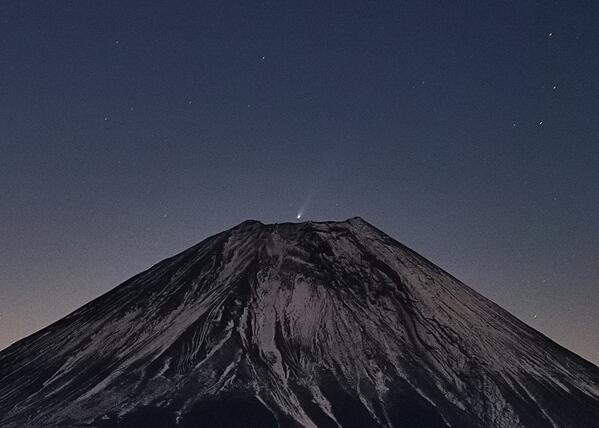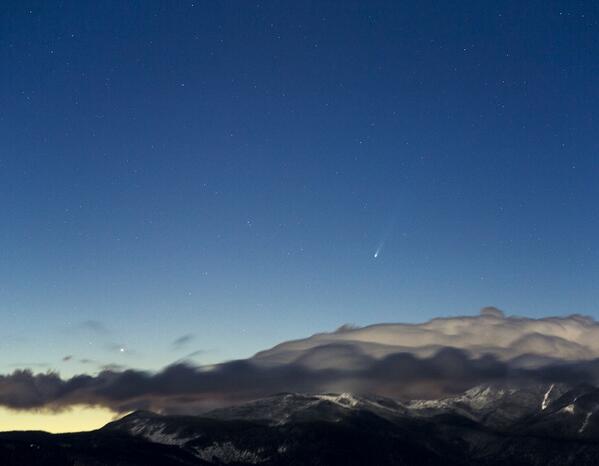Comet ISON, anticipated by skywatchers for more than a year, is brightening fast just days from its fateful hairpin swing on November 28 around the broiling surface of the sun. The comet is now a greenish-white fuzzy “star” in binoculars, low in the east-southeast at the beginning of dawn. Telescopic photos are showing it with a long, ribbony tail. The comet has flared with unexpected outbursts of gas and dust three times already this month.
Click here for more photos, plus charts showing ISON on November 24...

See full size | Comet ISON, imaged by longtime amateur astrophotograper Damian Peach in the U.K. He used a 4-inch f/5 telescope for 12 minutes of combined exposures on November 15th. Credit:Damian Peach / SkyandTelescope.com
What will emerge from its solar encounter into the dawns of early December?
“We might witness a nice, long-tailed comet visible to the naked eye that will leave millions of people with fond memories for a lifetime,” says Alan MacRobert, a senior editor of Sky & Telescope magazine. “Or maybe it will be a small comet for sky hunters using binoculars and a good map of its position. Or it might yet break up and vanish.”
It all depends on what happens to the comet’s tiny nucleus, its only solid part. A comet’s nucleus is a dirty iceball that’s just a pinpoint by astronomical standards — in this case less than a mile or two across. As it flies in from the cold outer solar system and warms in the heat of the sun, some of its ice evaporates, releasing gas and dust that expands by thousands or even millions of miles to become the comet’s glowing head (“coma”) and tail.
ISON will pass closest to the sun’s surface — by less than one sun diameter! — for a few hours on Thanksgiving Day, November 28th. (Closest time: around 2 p.m. EST; 19:00 Universal Time [GMT].) The sun will be enormous from the comet’s point of view, filling the comet’s sky and broiling its surface to a temperature of about 2,700 degrees C (4,900 degrees F). That’s hot enough to melt iron, not to mention ice. In addition, the sun’s tidal force (the difference in the sun’s gravitational force on the nucleus’s near and far sides), combined with the nucleus’s 10-hour rotation, could help to break it apart.
The closest approach to the sun is called perihelion. If ISON breaks up before then, as comets sometimes do, little or nothing visible may emerge from the other side of the close encounter. If the nucleus holds together, we might get a memorable celestial sight early in the December dawns, at least for people who know exactly where to look.
Check out this 20-second HD clip of a comet tumbling through space as it approaches the sun…
If the comet breaks into pieces around or after perihelion, the pieces wouldn’t disperse too far apart to show. More icy surface area would be exposed to the solar broiling, more dust and gas would blow off to make a brighter tail, and the December dawn show could be glorious.
No one yet knows what will happen.
Where to look
Even as it approaches the sun, the warming comet has brightened into binocular visibility. Amateur astronomers have also been taking spectacular long-exposure photos of it through telescopes, such as the one at the top of this page. (Click the image for a high-resolution version free for media use if credit is given as in the caption).
The naked-eye sightings of ISON that have been reported so far come from skilled observers under very dark skies using highly detailed star charts to pinpoint its exact location.
“If you want to try viewing ISON in binoculars before perihelion, don’t wait!” says Sky & Telescope associate editor Tony Flanders. “It’s appearing much lower each morning as it approaches the sun. Fortunately, it has also been brightening rapidly, so it’s actually getting a little easier to see. But nobody can guess how long that will continue.”
Find a spot with a completely unobstructed view of the east-southeast horizon. Start looking at least an hour before your local sunrise time and continue scanning the sky as dawn grows brighter. The planets Mercury and Saturn and the star Spica help to point the way, as shown in our daily dawn-scene graphics here. The comet symbol is exaggerated; it’s meant to show where the comet is, not to be a realistic picture. (Click the graphics for high-resolution versions, free for use with credit.)
A bonus comet!
A second comet is currently higher and easier to see in binoculars before dawn’s first light begins! That means looking at least 90 minutes before your local sunrise time. It’s named Comet Lovejoy C/2013 R1 (not to be confused with the other three Comet Lovejoys discovered by Terry Lovejoy of Australia). You’ll need to use Sky & Telescope’s detailed finder chart for it. Included with that is a similarly detailed chart for ISON among faint stars.
Watch a 16-second HD animation of a comet nearing the sun and beginning to release its gases in a spectacular display…
We’ll have more to say as ISON rounds the sun and its future becomes clear.
Background
A comet’s trajectory through the solar system is governed by the laws of gravity, so astronomers can predict months or years in advance exactly when and where a comet will appear in the sky. But how bright it will be is a lot less predictable. This is especially true of a “sun-grazer” comet like ISON.
Some sun-grazers have performed better than expected, such as Comet Ikeya-Seki in 1965 and Comet Lovejoy C/2011 W3 in 2011. Many experts predicted that the nucleus of the 2011 Comet Lovejoy would disintegrate during its very close pass by the sun that December, but it survived long enough before breaking up to produce a spectacular long tail easily visible for people in the Southern Hemisphere.
“All of us at Sky & Telescope are hoping that Comet ISON will be a glorious spectacle in December,” says Sky & Telescope editor in chief Robert Naeye. “But we also remember past comet flops such as Comet Kohoutek in 1974, which was actually a fairly nice comet but unfortunately fell far short of the hype. It’s important for the media to emphasize the unpredictable nature of comets, and that it’s by no means guaranteed that ISON will turn into a show-stopping comet later this year, or even one that most people will see at all without good charts and optical aid.”
ISON is named for the Russia-based International Scientific Optical Network, in which the comet’s discoverers, Artyom Novichonok and Vitali Nevski, were participating when they discovered the incoming comet in September 2012.


